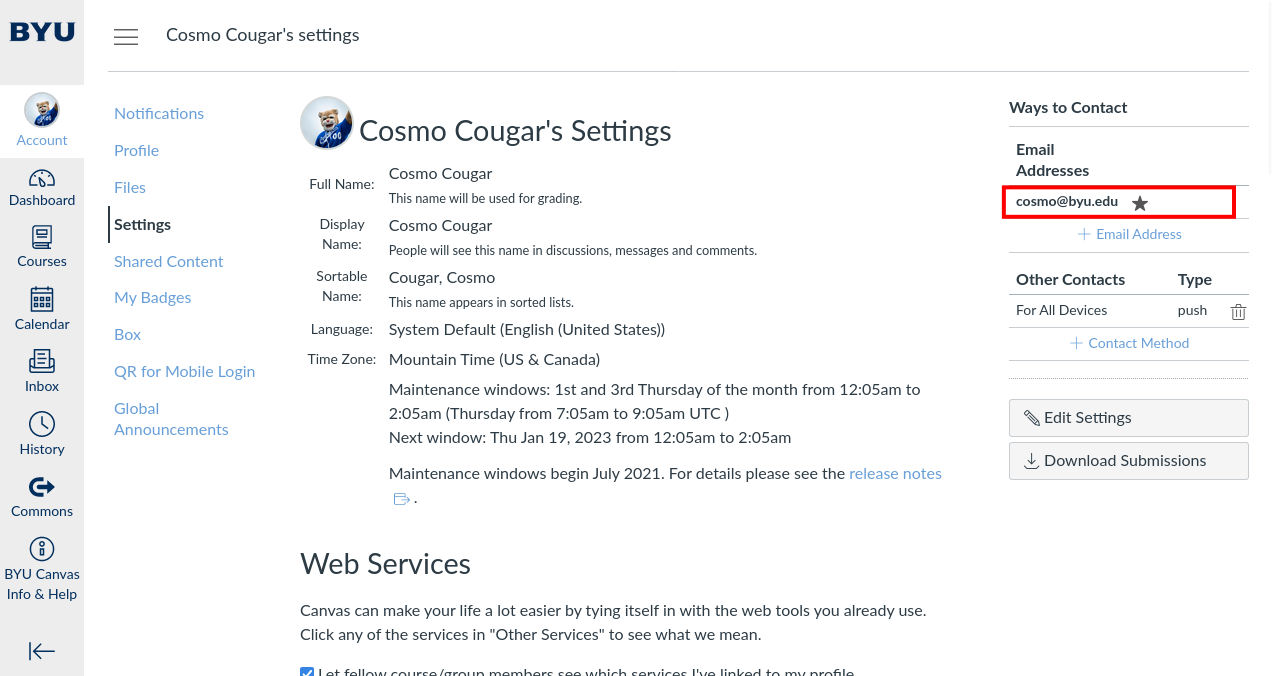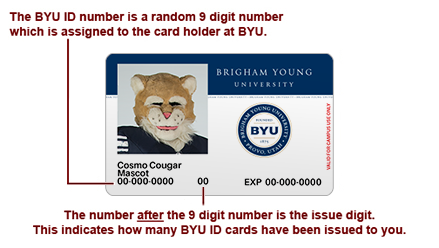Discussion 00: Getting Started
This is an online worksheet that you can work on during discussions. Your work is not graded and you do not need to submit anything.
Canvas and Gradescope Setup
To ensure your assignments can be submitted properly and your scores recorded accurately, please review the following instructions:
Canvas Email
In Canvas, make sure that the primary email is your BYU email.
- Go to Canvas.
- On the sidebar, go to Account, then click Settings.
- Check that your BYU email (netid@byu.edu) is shown and is set as the default email (has a star).

- If you do not see your BYU email or if there is no email listed, click + Email Address and enter your BYU email address in the dialog box and click the link that was sent to you.
- If your BYU email address is not the default email, hover over the listing and click the star.
Gradescope Email and Student ID
If you have never used Gradescope before, go to the C S 111 Canvas and click the Gradescope link once you have verified your Canvas email. An account will automatically be created for you.
If you have used Gradescope before and C S 111 is not showing up, sign into Gradescope in another tab and click the Gradescope link in the C S 111 Canvas.
To make sure that your accounts match up correctly, please complete the following steps:
- Sign into Gradescope.
- At the bottom of the page, go to Account, Edit Account.
- Make sure your Full Name matches the full name shown in Canvas.
- Make sure that your BYU email is shown under Email Addresses as the Primary Address.
- Make sure that your BYU Student ID (the 9-digit one on your ID card, not your Net ID) is shown under Student ID. If not, enter it without dashes (e.g., if your ID card reads
12-345-6789, enter123456789).

- If your BYU email is not showing, click Add Email and enter your BYU email and confirm it.

If you get a banner that says netid@byu.edu is already associated with a Gradescope account, you might have another Gradescope account and must merge your accounts. To do this, sign out of your current account, then sign into the Gradescope account associated with your BYU email. Next, head to the same Edit Account page. Then, click Merge Accounts and enter the email associated with your other Gradescope account.
Orientation
TOP SECRET!
You have been selected for an urgent mission. You will need a portable, internet enabled device (laptop or cell phone), good walking shoes, and weather-appropriate clothing. This mission will take approximately 1 hour. Make sure to use the same device to complete each step!
If you want to skip the interactive features, click here.
Phase 1: Establish Communication with the TAs
Most communication about assignments, due dates, and extra credit will be delivered via the CS 111 Discord Server. To ensure your academic success, join the server by going to https://cs111.byu.edu/discord.
Next, locate the text channel for your section. Open the channel to obtain the passcode and enter it below.
Phase 2: Locate the Open TA Help Lab
CS 111 is a demanding class. Many students turn to the internet when the going gets rough. Web searches can be useful, but the Open TA Help Lab is even better. Use the map below to locate the open TA help lab, and copy the passcode from the whiteboard into the box below.


Phase 3: Explore the Course Website
The CS 111 website is the most important resource to help you succeed in the course. It has all of the assignment specifications and due dates. In a new tab/window, go to the homepage and find the final due date for the Ants project. Enter it as your passcode in the format ants{mm/dd}. (e.g., ants{01/01})
Congratulations! You have completed Discussion 00: CS 111 Orientation.
Click here to show the orientation module again.
Click here to restart the orientation module.
Secrets to Success in CS 111
CS 111 is definitely a challenge, but we all want you to learn and succeed, so here is a collection of various tips that might help in your journey:
- Ask questions. If you encounter something you don't know or aren't sure about a concept or problem, ask away. We're here to help you learn, and if you ask a question, that tells us where we can help with your understanding of the material. The process of asking questions itself can also be helpful in figuring out for yourself what you would specifically like to ask about, and in therefore pinpointing concepts that you believe you can learn more about.
- Study in groups. Again, this class is not trivial; you might feel overwhelmed going at it alone. Send a message and reach out to other students in the class; work together on assignments or study together to prepare for exams, as long as you don't violate the course policy on Academic Honesty as stated in the Syllabus.
- When stuck on a problem, try to explain the area in which you are stuck. This doesn't need to require a person who understands how to solve the problem (or even a person - this practice is often referred to as rubber ducking since you can take a rubber duck and consider it your practice audience) because the main goal is for you to clarify your own thoughts and figure out where exactly you're getting stuck with your understanding and code. From there you can focus on that portion to better your understanding. 🦆
- If you're still feeling stuck, feel free to make use of the class Discord (our course forum for asking and answering questions) or attend office hours and visit the TA Help Lab.
- Office hours gives you time with the instructors or staff by themselves, and you will be able to get some (nearly) one-on-one instruction. You are not intruding; the instructors and staff are here to help as you learn.
- Do (or at least attempt seriously) all the homework. We do not give many homework problems, but those we do give you may find are challenging, time-consuming, and rewarding.
- Do all the lab exercises. Most of them are designed as more of an introduction to the course material, and may take around the length of a lab section. This is a great time to get acquainted with new material. Feel free to ask the staff members in your lab section or come to office hours if you would like more guidance.
- Optional lab questions are 'optional' in the sense that they are extra practice, not that they are material that's out of scope. Make sure you do them if you have time.
- Do the readings before lecture. They can be helpful in offering an overview of the material covered in lecture and other aspects of the class, as well as being a reference as part of the overall textbook that you can refer to as you go through the course.
- When preparing for the exams, do past exam questions! UC Berkeley CS61A has generously shared these with us. Lecture, lab, and discussion provide a great introduction to the material, but the main way to learn how to solve exam-level problems is to do exam-level problems. You can find past exams (and other resources) under the Resources tab of the website. Many past exams also have solutions or walkthrough videos where past staff members may walk you through the solution to the exam.